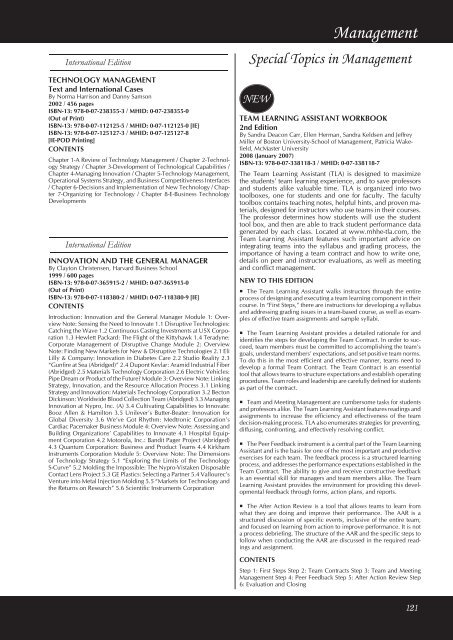Business Communication - McGraw-Hill Books
Business Communication - McGraw-Hill Books
Business Communication - McGraw-Hill Books
Create successful ePaper yourself
Turn your PDF publications into a flip-book with our unique Google optimized e-Paper software.
International EditionTECHNOLOGY MANAGEMENTText and International CasesBy Norma Harrison and Danny Samson2002 / 456 pagesISBN-13: 978-0-07-238355-3 / MHID: 0-07-238355-0(Out of Print)ISBN-13: 978-0-07-112125-5 / MHID: 0-07-112125-0 [IE]ISBN-13: 978-0-07-125127-3 / MHID: 0-07-125127-8[IE-POD Printing]CONTENTSChapter 1-A Review of Technology Management / Chapter 2-TechnologyStrategy / Chapter 3-Development of Technological Capabilities /Chapter 4-Managing Innovation / Chapter 5-Technology Management,Operational Systems Strategy, and <strong>Business</strong> Competitiveness Interfaces/ Chapter 6-Decisions and Implementation of New Technology / Chapter7-Organizing for Technology / Chapter 8-E-<strong>Business</strong> TechnologyDevelopmentsInternational EditionINNOVATION AND THE GENERAL MANAGERBy Clayton Christensen, Harvard <strong>Business</strong> School1999 / 600 pagesISBN-13: 978-0-07-365915-2 / MHID: 0-07-365915-0(Out of Print)ISBN-13: 978-0-07-118380-2 / MHID: 0-07-118380-9 [IE]CONTENTSIntroduction: Innovation and the General Manager Module 1: OverviewNote: Sensing the Need to Innovate 1.1 Disruptive Technologies:Catching the Wave 1.2 Continuous Casting Investments at USX Corporation1.3 Hewlett Packard: The Flight of the Kittyhawk 1.4 Teradyne:Corporate Management of Disruptive Change Module 2: OverviewNote: Finding New Markets for New & Disruptive Technologies 2.1 EliLilly & Company: Innovation in Diabetes Care 2.2 Studio Reality 2.3“Gunfire at Sea (Abridged)” 2.4 Dupont Kevlar: Aramid Industrial Fiber(Abridged) 2.5 Materials Technology Corporation 2.6 Electric Vehicles:Pipe Dream or Product of the Future? Module 3: Overview Note: LinkingStrategy, Innovation, and the Resource Allocation Process 3.1 LinkingStrategy and Innovation: Materials Technology Corporation 3.2 BectonDickinson: Worldwide Blood Collection Team (Abridged) 3.3 ManagingInnovation at Nypro, Inc. (A) 3.4 Cultivating Capabilities to Innovate:Booz Allen & Hamilton 3.5 Unilever’s Butter-Beater: Innovation forGlobal Diversity 3.6 We’ve Got Rhythm: Medtronic Corporation’sCardiac Pacemaker <strong>Business</strong> Module 4: Overview Note: Assessing andBuilding Organizations’ Capabilities to Innovate 4.1 Hospital EquipmentCorporation 4.2 Motorola, Inc.: Bandit Pager Project (Abridged)4.3 Quantum Corporation: <strong>Business</strong> and Product Teams 4.4 KirkhamInstruments Corporation Module 5: Overview Note: The Dimensionsof Technology Strategy 5.1 “Exploring the Limits of the TechnologyS-Curve” 5.2 Molding the Impossible: The Nypro-Vistaken DisposableContact Lens Project 5.3 GE Plastics: Selecting a Partner 5.4 Vallourec’sVenture into Metal Injection Molding 5.5 “Markets for Technology andthe Returns on Research” 5.6 Scientific Instruments CorporationSpecial Topics in ManagementNEWManagementTEAM LEARNING ASSISTANT WORKBOOK2nd EditionBy Sandra Deacon Carr, Ellen Herman, Sandra Keldsen and JeffreyMiller of Boston University-School of Management, Patricia Wakefield,McMaster University2008 (January 2007)ISBN-13: 978-0-07-338118-3 / MHID: 0-07-338118-7The Team Learning Assistant (TLA) is designed to maximizethe students’ team learning experience, and to save professorsand students alike valuable time. TLA is organized into twotoolboxes, one for students and one for faculty. The facultytoolbox contains teaching notes, helpful hints, and proven materials,designed for instructors who use teams in their courses.The professor determines how students will use the studenttool box, and then are able to track student performance datagenerated by each class. Located at www.mhhe-tla.com, theTeam Learning Assistant features such important advice onintegrating teams into the syllabus and grading process, theimportance of having a team contract and how to write one,details on peer and instructor evaluations, as well as meetingand conflict management.NEW TO THIS EDITION• The Team Learning Assistant walks instructors through the entireprocess of designing and executing a team learning component in theircourse. In “First Steps,” there are instructions for developing a syllabusand addressing grading issues in a team-based course, as well as examplesof effective team assignments and sample syllabi.• The Team Learning Assistant provides a detailed rationale for andidentifies the steps for developing the Team Contract. In order to succeed,team members must be committed to accomplishing the team’sgoals, understand members’ expectations, and set positive team norms.To do this in the most efficient and effective manner, teams need todevelop a formal Team Contract. The Team Contract is an essentialtool that allows teams to structure expectations and establish operatingprocedures. Team roles and leadership are carefully defined for studentsas part of the contract.• Team and Meeting Management are cumbersome tasks for studentsand professors alike. The Team Learning Assistant features readings andassignments to increase the efficiency and effectiveness of the teamdecision-making process. TLA also enumerates strategies for preventing,diffusing, confronting, and effectively resolving conflict.• The Peer Feedback instrument is a central part of the Team LearningAssistant and is the basis for one of the most important and productiveexercises for each team. The feedback process is a structured learningprocess, and addresses the performance expectations established in theTeam Contract. The ability to give and receive constructive feedbackis an essential skill for managers and team members alike. The TeamLearning Assistant provides the environment for providing this developmentalfeedback through forms, action plans, and reports.• The After Action Review is a tool that allows teams to learn fromwhat they are doing and improve their performance. The AAR is astructured discussion of specific events, inclusive of the entire team,and focused on learning from action to improve performance. It is nota process debriefing. The structure of the AAR and the specific steps tofollow when conducting the AAR are discussed in the required readingsand assignment.CONTENTSStep 1: First Steps Step 2: Team Contracts Step 3: Team and MeetingManagement Step 4: Peer Feedback Step 5: After Action Review Step6: Evaluation and Closing121HED 2007 Management.indd 12110/5/2006 1:24:32 PM

















